Causes and Impact of Employee Demotivation in Organisations
VerifiedAdded on 2022/12/22
|9
|2194
|1
AI Summary
This report examines the causes and impact of employee demotivation in organisations. It discusses factors such as poor work conditions, relationship with management, low wages, and poor organisational culture that contribute to demotivation. The report also explores the negative effects of demotivation on organisational performance, including high turnover and poor communication. Additionally, it provides five strategies to improve employee motivation, such as establishing a good relationship with management, creating a positive work environment, offering competitive salary and benefits, fostering an attractive work culture, and providing growth and development opportunities.
Contribute Materials
Your contribution can guide someone’s learning journey. Share your
documents today.
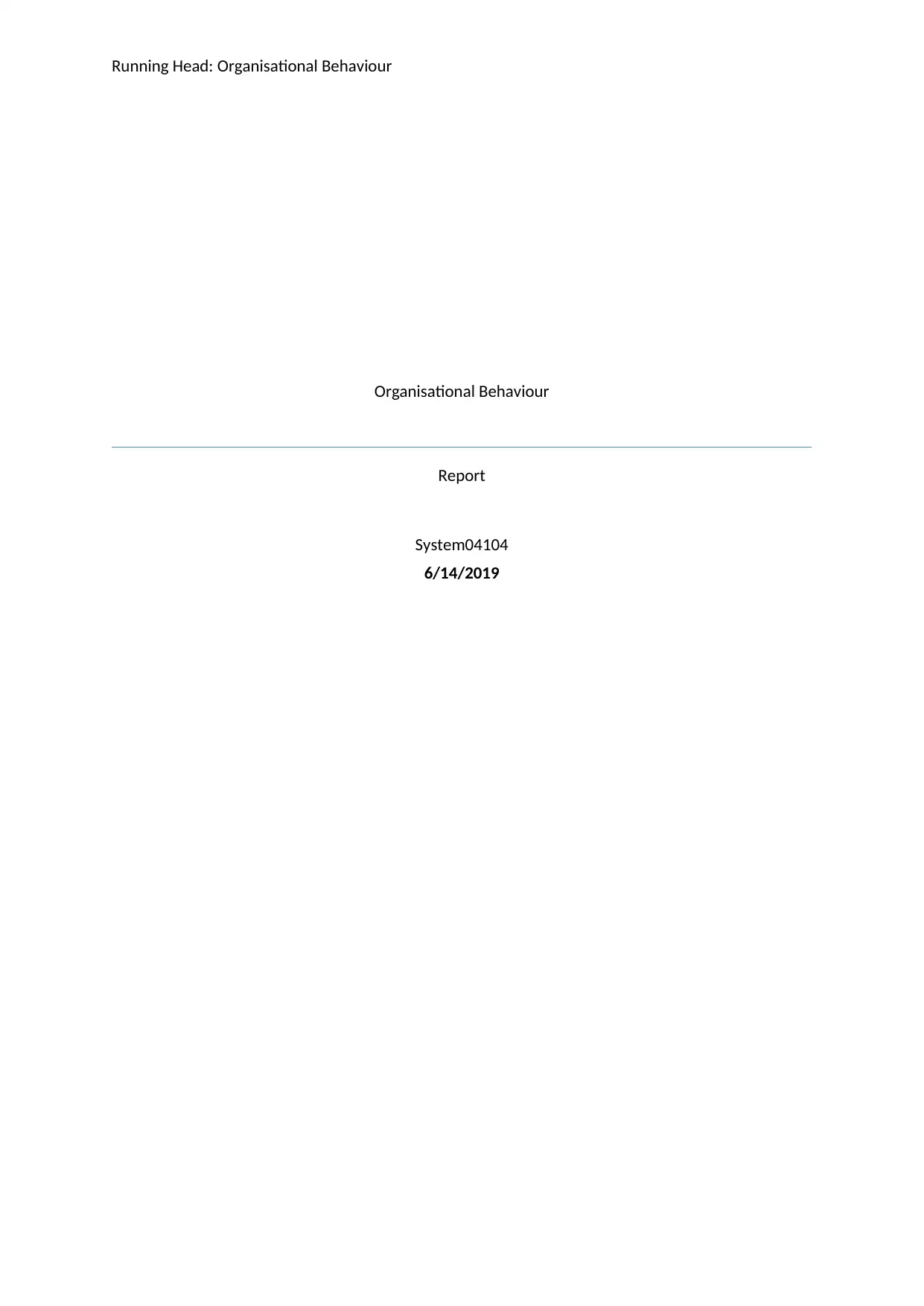
Running Head: Organisational Behaviour
Organisational Behaviour
Report
System04104
6/14/2019
Organisational Behaviour
Report
System04104
6/14/2019
Secure Best Marks with AI Grader
Need help grading? Try our AI Grader for instant feedback on your assignments.
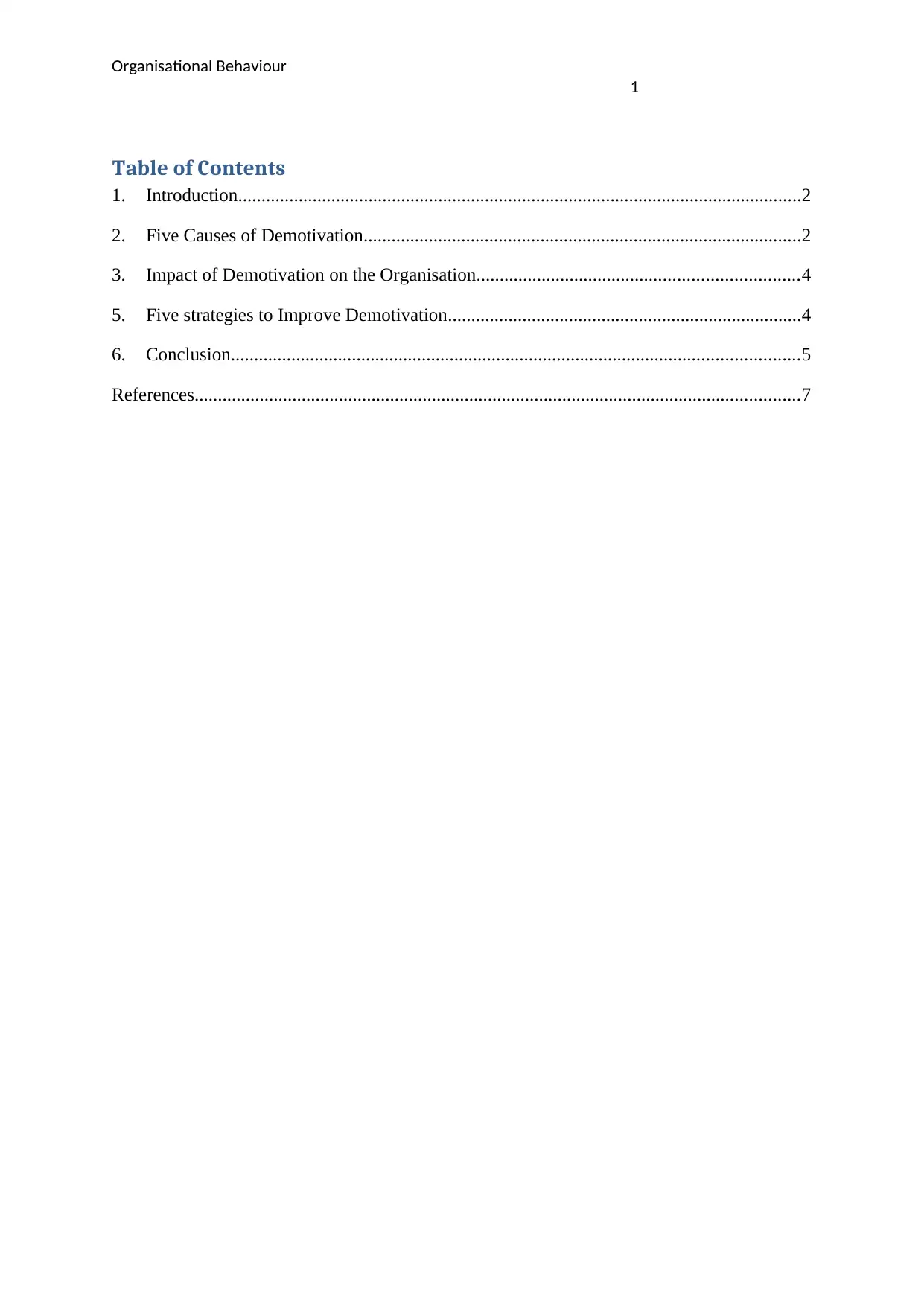
Organisational Behaviour
1
Table of Contents
1. Introduction.........................................................................................................................2
2. Five Causes of Demotivation..............................................................................................2
3. Impact of Demotivation on the Organisation.....................................................................4
5. Five strategies to Improve Demotivation............................................................................4
6. Conclusion..........................................................................................................................5
References..................................................................................................................................7
1
Table of Contents
1. Introduction.........................................................................................................................2
2. Five Causes of Demotivation..............................................................................................2
3. Impact of Demotivation on the Organisation.....................................................................4
5. Five strategies to Improve Demotivation............................................................................4
6. Conclusion..........................................................................................................................5
References..................................................................................................................................7
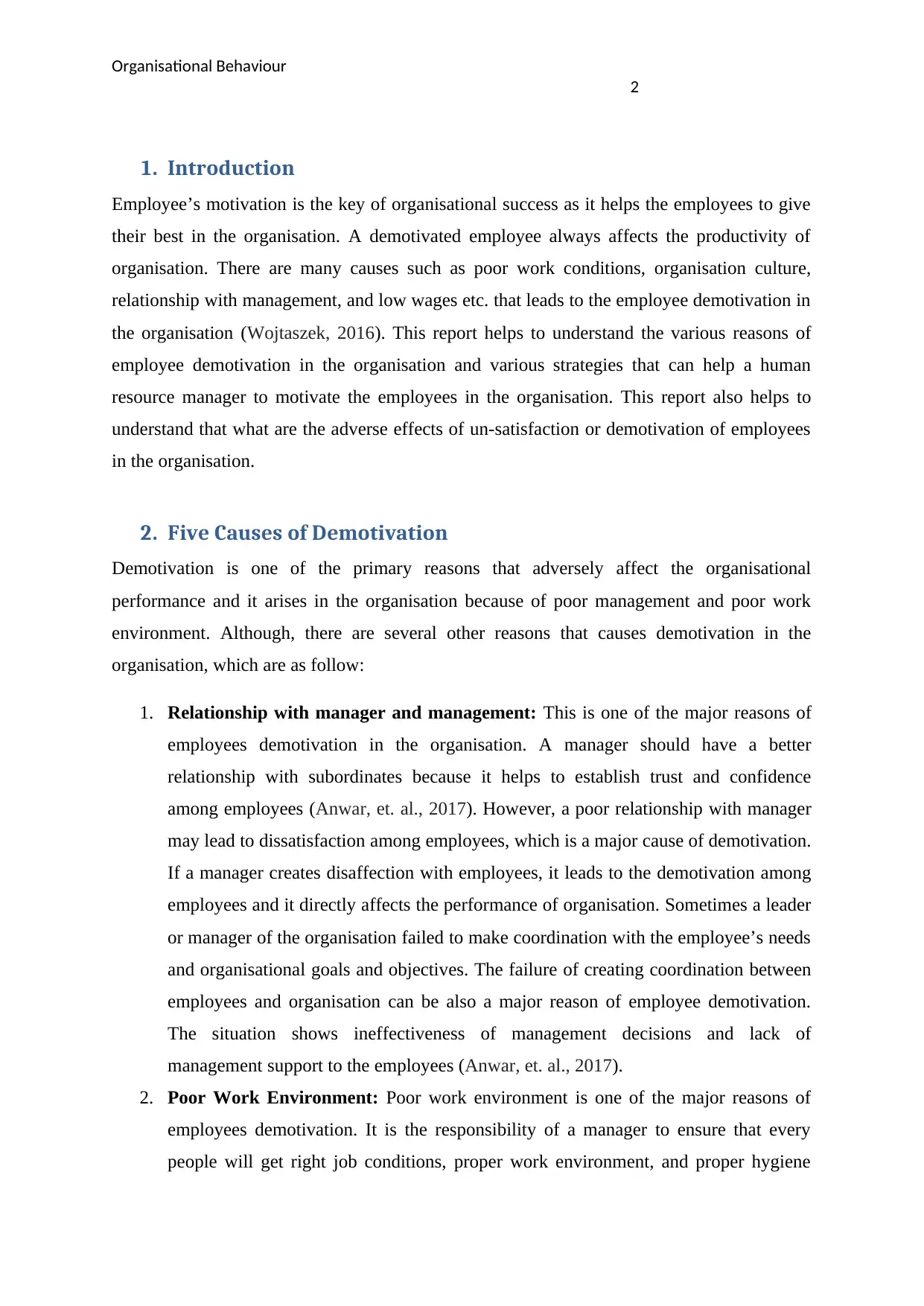
Organisational Behaviour
2
1. Introduction
Employee’s motivation is the key of organisational success as it helps the employees to give
their best in the organisation. A demotivated employee always affects the productivity of
organisation. There are many causes such as poor work conditions, organisation culture,
relationship with management, and low wages etc. that leads to the employee demotivation in
the organisation (Wojtaszek, 2016). This report helps to understand the various reasons of
employee demotivation in the organisation and various strategies that can help a human
resource manager to motivate the employees in the organisation. This report also helps to
understand that what are the adverse effects of un-satisfaction or demotivation of employees
in the organisation.
2. Five Causes of Demotivation
Demotivation is one of the primary reasons that adversely affect the organisational
performance and it arises in the organisation because of poor management and poor work
environment. Although, there are several other reasons that causes demotivation in the
organisation, which are as follow:
1. Relationship with manager and management: This is one of the major reasons of
employees demotivation in the organisation. A manager should have a better
relationship with subordinates because it helps to establish trust and confidence
among employees (Anwar, et. al., 2017). However, a poor relationship with manager
may lead to dissatisfaction among employees, which is a major cause of demotivation.
If a manager creates disaffection with employees, it leads to the demotivation among
employees and it directly affects the performance of organisation. Sometimes a leader
or manager of the organisation failed to make coordination with the employee’s needs
and organisational goals and objectives. The failure of creating coordination between
employees and organisation can be also a major reason of employee demotivation.
The situation shows ineffectiveness of management decisions and lack of
management support to the employees (Anwar, et. al., 2017).
2. Poor Work Environment: Poor work environment is one of the major reasons of
employees demotivation. It is the responsibility of a manager to ensure that every
people will get right job conditions, proper work environment, and proper hygiene
2
1. Introduction
Employee’s motivation is the key of organisational success as it helps the employees to give
their best in the organisation. A demotivated employee always affects the productivity of
organisation. There are many causes such as poor work conditions, organisation culture,
relationship with management, and low wages etc. that leads to the employee demotivation in
the organisation (Wojtaszek, 2016). This report helps to understand the various reasons of
employee demotivation in the organisation and various strategies that can help a human
resource manager to motivate the employees in the organisation. This report also helps to
understand that what are the adverse effects of un-satisfaction or demotivation of employees
in the organisation.
2. Five Causes of Demotivation
Demotivation is one of the primary reasons that adversely affect the organisational
performance and it arises in the organisation because of poor management and poor work
environment. Although, there are several other reasons that causes demotivation in the
organisation, which are as follow:
1. Relationship with manager and management: This is one of the major reasons of
employees demotivation in the organisation. A manager should have a better
relationship with subordinates because it helps to establish trust and confidence
among employees (Anwar, et. al., 2017). However, a poor relationship with manager
may lead to dissatisfaction among employees, which is a major cause of demotivation.
If a manager creates disaffection with employees, it leads to the demotivation among
employees and it directly affects the performance of organisation. Sometimes a leader
or manager of the organisation failed to make coordination with the employee’s needs
and organisational goals and objectives. The failure of creating coordination between
employees and organisation can be also a major reason of employee demotivation.
The situation shows ineffectiveness of management decisions and lack of
management support to the employees (Anwar, et. al., 2017).
2. Poor Work Environment: Poor work environment is one of the major reasons of
employees demotivation. It is the responsibility of a manager to ensure that every
people will get right job conditions, proper work environment, and proper hygiene
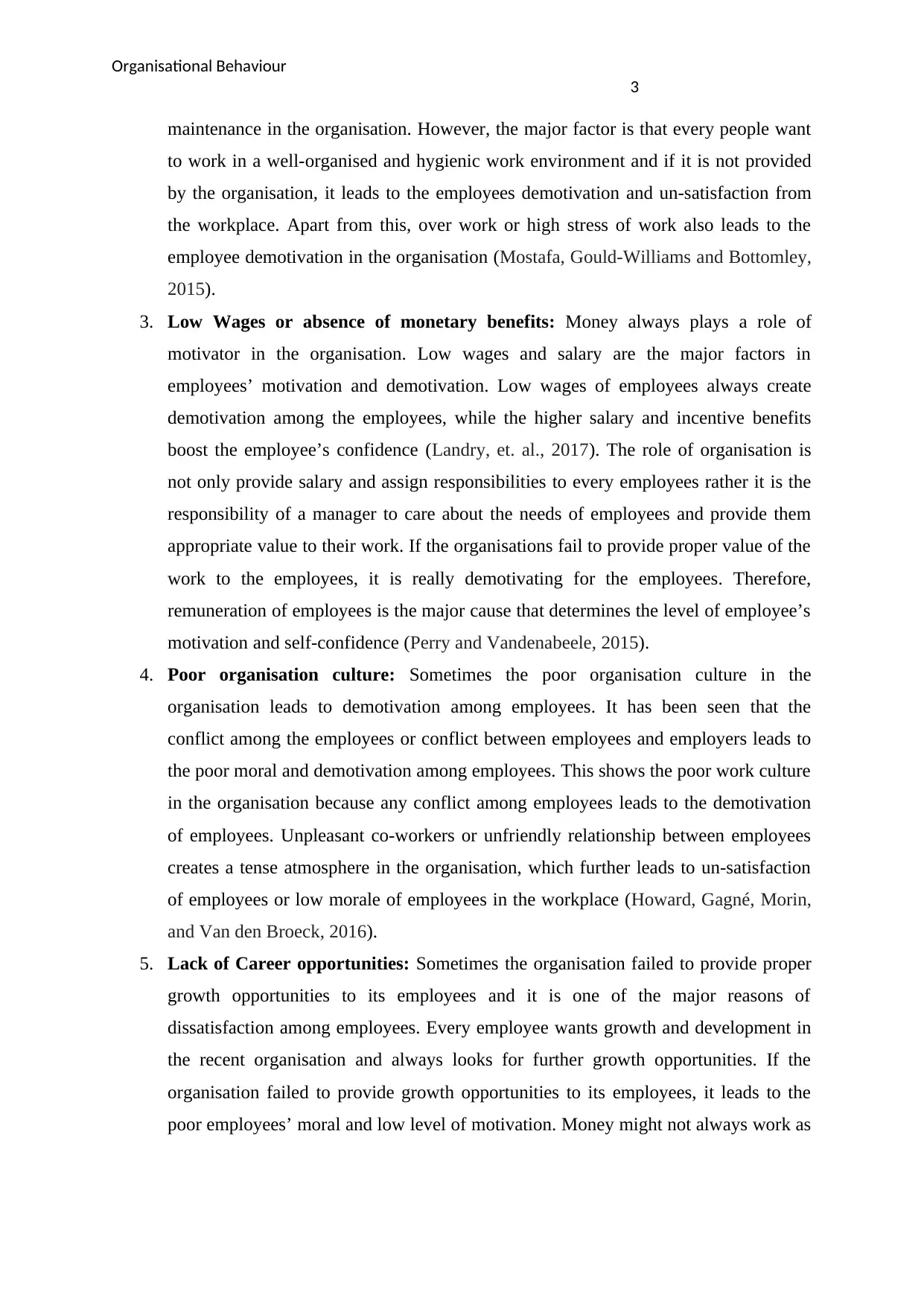
Organisational Behaviour
3
maintenance in the organisation. However, the major factor is that every people want
to work in a well-organised and hygienic work environment and if it is not provided
by the organisation, it leads to the employees demotivation and un-satisfaction from
the workplace. Apart from this, over work or high stress of work also leads to the
employee demotivation in the organisation (Mostafa, Gould-Williams and Bottomley,
2015).
3. Low Wages or absence of monetary benefits: Money always plays a role of
motivator in the organisation. Low wages and salary are the major factors in
employees’ motivation and demotivation. Low wages of employees always create
demotivation among the employees, while the higher salary and incentive benefits
boost the employee’s confidence (Landry, et. al., 2017). The role of organisation is
not only provide salary and assign responsibilities to every employees rather it is the
responsibility of a manager to care about the needs of employees and provide them
appropriate value to their work. If the organisations fail to provide proper value of the
work to the employees, it is really demotivating for the employees. Therefore,
remuneration of employees is the major cause that determines the level of employee’s
motivation and self-confidence (Perry and Vandenabeele, 2015).
4. Poor organisation culture: Sometimes the poor organisation culture in the
organisation leads to demotivation among employees. It has been seen that the
conflict among the employees or conflict between employees and employers leads to
the poor moral and demotivation among employees. This shows the poor work culture
in the organisation because any conflict among employees leads to the demotivation
of employees. Unpleasant co-workers or unfriendly relationship between employees
creates a tense atmosphere in the organisation, which further leads to un-satisfaction
of employees or low morale of employees in the workplace (Howard, Gagné, Morin,
and Van den Broeck, 2016).
5. Lack of Career opportunities: Sometimes the organisation failed to provide proper
growth opportunities to its employees and it is one of the major reasons of
dissatisfaction among employees. Every employee wants growth and development in
the recent organisation and always looks for further growth opportunities. If the
organisation failed to provide growth opportunities to its employees, it leads to the
poor employees’ moral and low level of motivation. Money might not always work as
3
maintenance in the organisation. However, the major factor is that every people want
to work in a well-organised and hygienic work environment and if it is not provided
by the organisation, it leads to the employees demotivation and un-satisfaction from
the workplace. Apart from this, over work or high stress of work also leads to the
employee demotivation in the organisation (Mostafa, Gould-Williams and Bottomley,
2015).
3. Low Wages or absence of monetary benefits: Money always plays a role of
motivator in the organisation. Low wages and salary are the major factors in
employees’ motivation and demotivation. Low wages of employees always create
demotivation among the employees, while the higher salary and incentive benefits
boost the employee’s confidence (Landry, et. al., 2017). The role of organisation is
not only provide salary and assign responsibilities to every employees rather it is the
responsibility of a manager to care about the needs of employees and provide them
appropriate value to their work. If the organisations fail to provide proper value of the
work to the employees, it is really demotivating for the employees. Therefore,
remuneration of employees is the major cause that determines the level of employee’s
motivation and self-confidence (Perry and Vandenabeele, 2015).
4. Poor organisation culture: Sometimes the poor organisation culture in the
organisation leads to demotivation among employees. It has been seen that the
conflict among the employees or conflict between employees and employers leads to
the poor moral and demotivation among employees. This shows the poor work culture
in the organisation because any conflict among employees leads to the demotivation
of employees. Unpleasant co-workers or unfriendly relationship between employees
creates a tense atmosphere in the organisation, which further leads to un-satisfaction
of employees or low morale of employees in the workplace (Howard, Gagné, Morin,
and Van den Broeck, 2016).
5. Lack of Career opportunities: Sometimes the organisation failed to provide proper
growth opportunities to its employees and it is one of the major reasons of
dissatisfaction among employees. Every employee wants growth and development in
the recent organisation and always looks for further growth opportunities. If the
organisation failed to provide growth opportunities to its employees, it leads to the
poor employees’ moral and low level of motivation. Money might not always work as
Secure Best Marks with AI Grader
Need help grading? Try our AI Grader for instant feedback on your assignments.
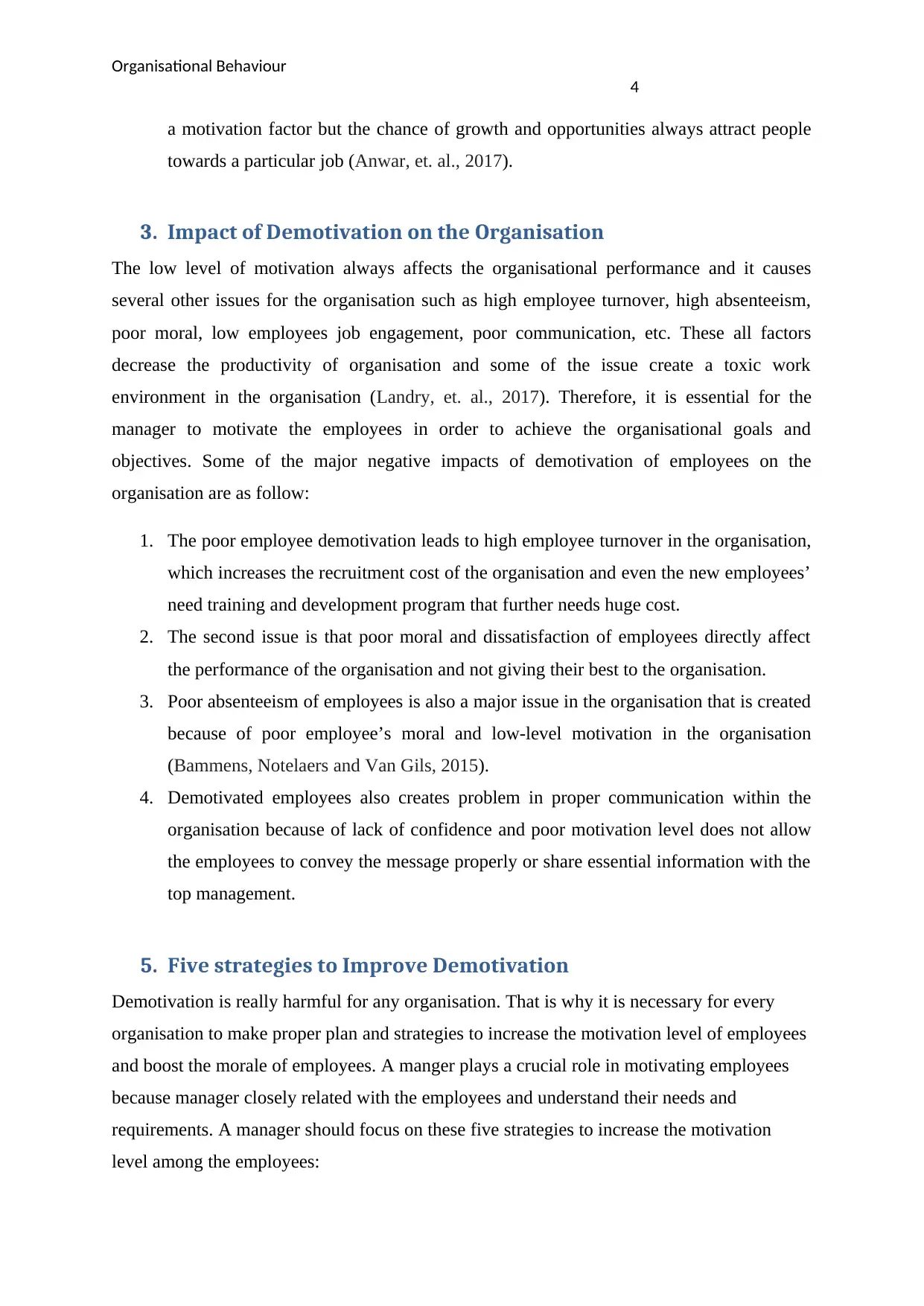
Organisational Behaviour
4
a motivation factor but the chance of growth and opportunities always attract people
towards a particular job (Anwar, et. al., 2017).
3. Impact of Demotivation on the Organisation
The low level of motivation always affects the organisational performance and it causes
several other issues for the organisation such as high employee turnover, high absenteeism,
poor moral, low employees job engagement, poor communication, etc. These all factors
decrease the productivity of organisation and some of the issue create a toxic work
environment in the organisation (Landry, et. al., 2017). Therefore, it is essential for the
manager to motivate the employees in order to achieve the organisational goals and
objectives. Some of the major negative impacts of demotivation of employees on the
organisation are as follow:
1. The poor employee demotivation leads to high employee turnover in the organisation,
which increases the recruitment cost of the organisation and even the new employees’
need training and development program that further needs huge cost.
2. The second issue is that poor moral and dissatisfaction of employees directly affect
the performance of the organisation and not giving their best to the organisation.
3. Poor absenteeism of employees is also a major issue in the organisation that is created
because of poor employee’s moral and low-level motivation in the organisation
(Bammens, Notelaers and Van Gils, 2015).
4. Demotivated employees also creates problem in proper communication within the
organisation because of lack of confidence and poor motivation level does not allow
the employees to convey the message properly or share essential information with the
top management.
5. Five strategies to Improve Demotivation
Demotivation is really harmful for any organisation. That is why it is necessary for every
organisation to make proper plan and strategies to increase the motivation level of employees
and boost the morale of employees. A manger plays a crucial role in motivating employees
because manager closely related with the employees and understand their needs and
requirements. A manager should focus on these five strategies to increase the motivation
level among the employees:
4
a motivation factor but the chance of growth and opportunities always attract people
towards a particular job (Anwar, et. al., 2017).
3. Impact of Demotivation on the Organisation
The low level of motivation always affects the organisational performance and it causes
several other issues for the organisation such as high employee turnover, high absenteeism,
poor moral, low employees job engagement, poor communication, etc. These all factors
decrease the productivity of organisation and some of the issue create a toxic work
environment in the organisation (Landry, et. al., 2017). Therefore, it is essential for the
manager to motivate the employees in order to achieve the organisational goals and
objectives. Some of the major negative impacts of demotivation of employees on the
organisation are as follow:
1. The poor employee demotivation leads to high employee turnover in the organisation,
which increases the recruitment cost of the organisation and even the new employees’
need training and development program that further needs huge cost.
2. The second issue is that poor moral and dissatisfaction of employees directly affect
the performance of the organisation and not giving their best to the organisation.
3. Poor absenteeism of employees is also a major issue in the organisation that is created
because of poor employee’s moral and low-level motivation in the organisation
(Bammens, Notelaers and Van Gils, 2015).
4. Demotivated employees also creates problem in proper communication within the
organisation because of lack of confidence and poor motivation level does not allow
the employees to convey the message properly or share essential information with the
top management.
5. Five strategies to Improve Demotivation
Demotivation is really harmful for any organisation. That is why it is necessary for every
organisation to make proper plan and strategies to increase the motivation level of employees
and boost the morale of employees. A manger plays a crucial role in motivating employees
because manager closely related with the employees and understand their needs and
requirements. A manager should focus on these five strategies to increase the motivation
level among the employees:
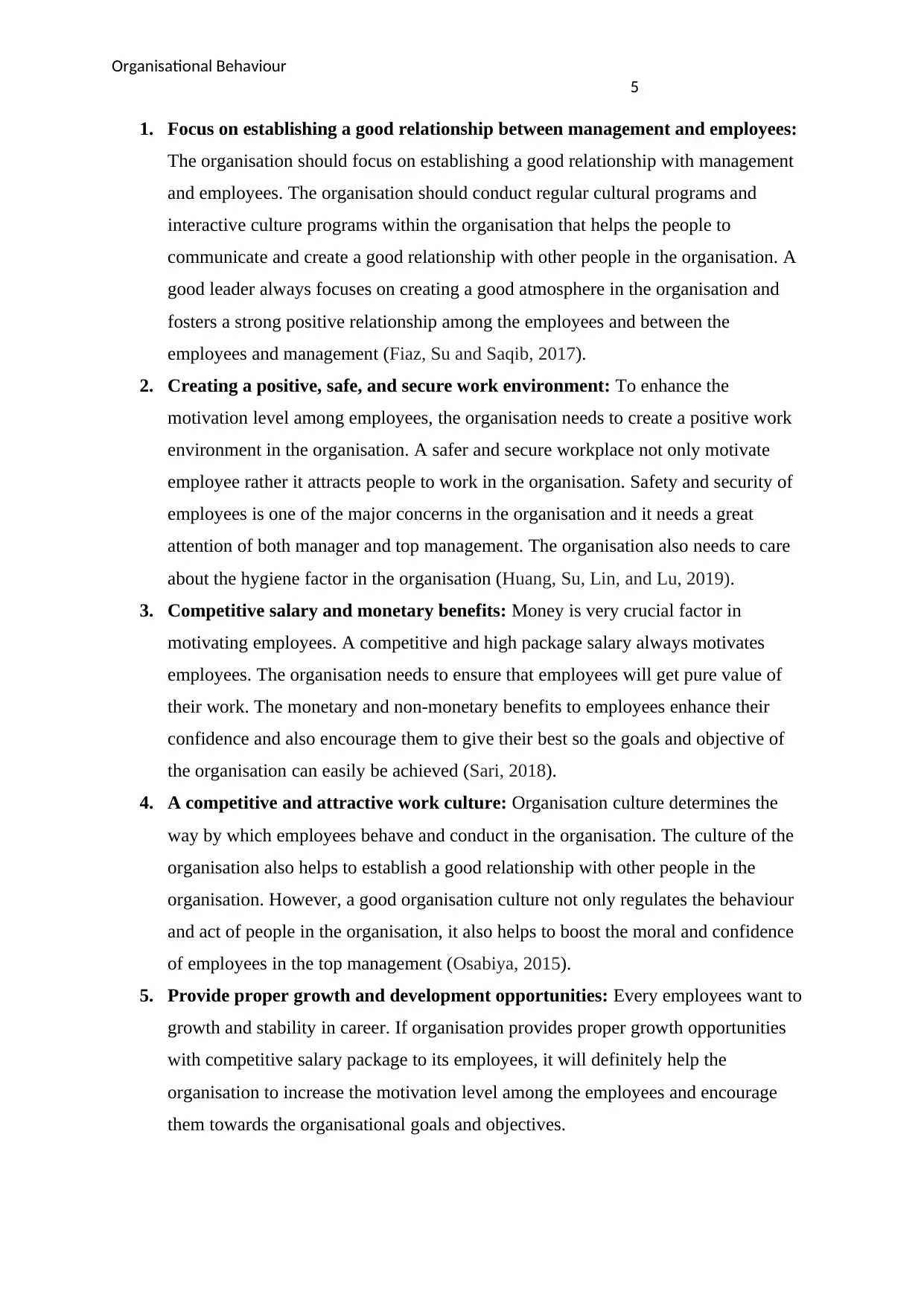
Organisational Behaviour
5
1. Focus on establishing a good relationship between management and employees:
The organisation should focus on establishing a good relationship with management
and employees. The organisation should conduct regular cultural programs and
interactive culture programs within the organisation that helps the people to
communicate and create a good relationship with other people in the organisation. A
good leader always focuses on creating a good atmosphere in the organisation and
fosters a strong positive relationship among the employees and between the
employees and management (Fiaz, Su and Saqib, 2017).
2. Creating a positive, safe, and secure work environment: To enhance the
motivation level among employees, the organisation needs to create a positive work
environment in the organisation. A safer and secure workplace not only motivate
employee rather it attracts people to work in the organisation. Safety and security of
employees is one of the major concerns in the organisation and it needs a great
attention of both manager and top management. The organisation also needs to care
about the hygiene factor in the organisation (Huang, Su, Lin, and Lu, 2019).
3. Competitive salary and monetary benefits: Money is very crucial factor in
motivating employees. A competitive and high package salary always motivates
employees. The organisation needs to ensure that employees will get pure value of
their work. The monetary and non-monetary benefits to employees enhance their
confidence and also encourage them to give their best so the goals and objective of
the organisation can easily be achieved (Sari, 2018).
4. A competitive and attractive work culture: Organisation culture determines the
way by which employees behave and conduct in the organisation. The culture of the
organisation also helps to establish a good relationship with other people in the
organisation. However, a good organisation culture not only regulates the behaviour
and act of people in the organisation, it also helps to boost the moral and confidence
of employees in the top management (Osabiya, 2015).
5. Provide proper growth and development opportunities: Every employees want to
growth and stability in career. If organisation provides proper growth opportunities
with competitive salary package to its employees, it will definitely help the
organisation to increase the motivation level among the employees and encourage
them towards the organisational goals and objectives.
5
1. Focus on establishing a good relationship between management and employees:
The organisation should focus on establishing a good relationship with management
and employees. The organisation should conduct regular cultural programs and
interactive culture programs within the organisation that helps the people to
communicate and create a good relationship with other people in the organisation. A
good leader always focuses on creating a good atmosphere in the organisation and
fosters a strong positive relationship among the employees and between the
employees and management (Fiaz, Su and Saqib, 2017).
2. Creating a positive, safe, and secure work environment: To enhance the
motivation level among employees, the organisation needs to create a positive work
environment in the organisation. A safer and secure workplace not only motivate
employee rather it attracts people to work in the organisation. Safety and security of
employees is one of the major concerns in the organisation and it needs a great
attention of both manager and top management. The organisation also needs to care
about the hygiene factor in the organisation (Huang, Su, Lin, and Lu, 2019).
3. Competitive salary and monetary benefits: Money is very crucial factor in
motivating employees. A competitive and high package salary always motivates
employees. The organisation needs to ensure that employees will get pure value of
their work. The monetary and non-monetary benefits to employees enhance their
confidence and also encourage them to give their best so the goals and objective of
the organisation can easily be achieved (Sari, 2018).
4. A competitive and attractive work culture: Organisation culture determines the
way by which employees behave and conduct in the organisation. The culture of the
organisation also helps to establish a good relationship with other people in the
organisation. However, a good organisation culture not only regulates the behaviour
and act of people in the organisation, it also helps to boost the moral and confidence
of employees in the top management (Osabiya, 2015).
5. Provide proper growth and development opportunities: Every employees want to
growth and stability in career. If organisation provides proper growth opportunities
with competitive salary package to its employees, it will definitely help the
organisation to increase the motivation level among the employees and encourage
them towards the organisational goals and objectives.
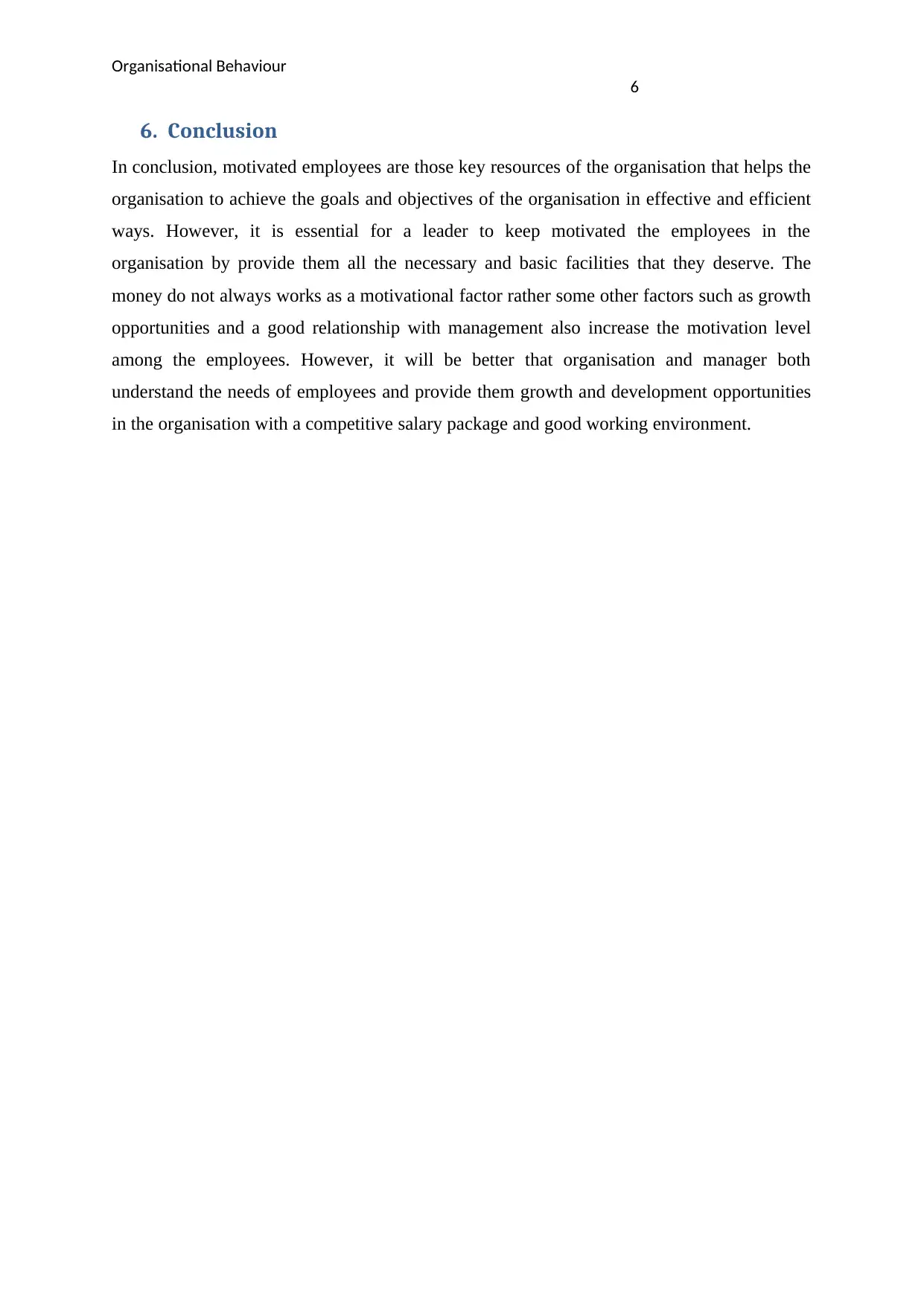
Organisational Behaviour
6
6. Conclusion
In conclusion, motivated employees are those key resources of the organisation that helps the
organisation to achieve the goals and objectives of the organisation in effective and efficient
ways. However, it is essential for a leader to keep motivated the employees in the
organisation by provide them all the necessary and basic facilities that they deserve. The
money do not always works as a motivational factor rather some other factors such as growth
opportunities and a good relationship with management also increase the motivation level
among the employees. However, it will be better that organisation and manager both
understand the needs of employees and provide them growth and development opportunities
in the organisation with a competitive salary package and good working environment.
6
6. Conclusion
In conclusion, motivated employees are those key resources of the organisation that helps the
organisation to achieve the goals and objectives of the organisation in effective and efficient
ways. However, it is essential for a leader to keep motivated the employees in the
organisation by provide them all the necessary and basic facilities that they deserve. The
money do not always works as a motivational factor rather some other factors such as growth
opportunities and a good relationship with management also increase the motivation level
among the employees. However, it will be better that organisation and manager both
understand the needs of employees and provide them growth and development opportunities
in the organisation with a competitive salary package and good working environment.
Paraphrase This Document
Need a fresh take? Get an instant paraphrase of this document with our AI Paraphraser
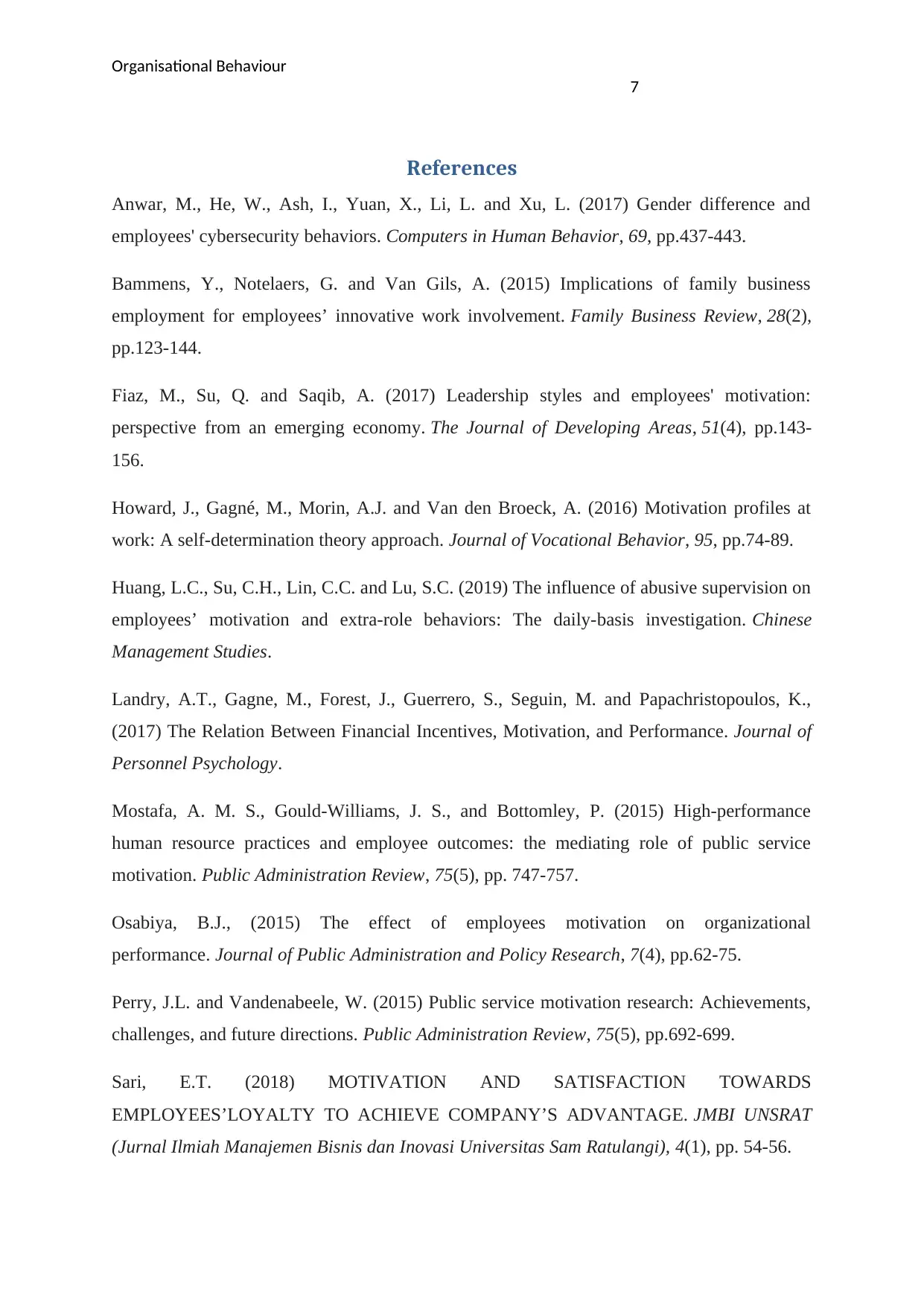
Organisational Behaviour
7
References
Anwar, M., He, W., Ash, I., Yuan, X., Li, L. and Xu, L. (2017) Gender difference and
employees' cybersecurity behaviors. Computers in Human Behavior, 69, pp.437-443.
Bammens, Y., Notelaers, G. and Van Gils, A. (2015) Implications of family business
employment for employees’ innovative work involvement. Family Business Review, 28(2),
pp.123-144.
Fiaz, M., Su, Q. and Saqib, A. (2017) Leadership styles and employees' motivation:
perspective from an emerging economy. The Journal of Developing Areas, 51(4), pp.143-
156.
Howard, J., Gagné, M., Morin, A.J. and Van den Broeck, A. (2016) Motivation profiles at
work: A self-determination theory approach. Journal of Vocational Behavior, 95, pp.74-89.
Huang, L.C., Su, C.H., Lin, C.C. and Lu, S.C. (2019) The influence of abusive supervision on
employees’ motivation and extra-role behaviors: The daily-basis investigation. Chinese
Management Studies.
Landry, A.T., Gagne, M., Forest, J., Guerrero, S., Seguin, M. and Papachristopoulos, K.,
(2017) The Relation Between Financial Incentives, Motivation, and Performance. Journal of
Personnel Psychology.
Mostafa, A. M. S., Gould‐Williams, J. S., and Bottomley, P. (2015) High‐performance
human resource practices and employee outcomes: the mediating role of public service
motivation. Public Administration Review, 75(5), pp. 747-757.
Osabiya, B.J., (2015) The effect of employees motivation on organizational
performance. Journal of Public Administration and Policy Research, 7(4), pp.62-75.
Perry, J.L. and Vandenabeele, W. (2015) Public service motivation research: Achievements,
challenges, and future directions. Public Administration Review, 75(5), pp.692-699.
Sari, E.T. (2018) MOTIVATION AND SATISFACTION TOWARDS
EMPLOYEES’LOYALTY TO ACHIEVE COMPANY’S ADVANTAGE. JMBI UNSRAT
(Jurnal Ilmiah Manajemen Bisnis dan Inovasi Universitas Sam Ratulangi), 4(1), pp. 54-56.
7
References
Anwar, M., He, W., Ash, I., Yuan, X., Li, L. and Xu, L. (2017) Gender difference and
employees' cybersecurity behaviors. Computers in Human Behavior, 69, pp.437-443.
Bammens, Y., Notelaers, G. and Van Gils, A. (2015) Implications of family business
employment for employees’ innovative work involvement. Family Business Review, 28(2),
pp.123-144.
Fiaz, M., Su, Q. and Saqib, A. (2017) Leadership styles and employees' motivation:
perspective from an emerging economy. The Journal of Developing Areas, 51(4), pp.143-
156.
Howard, J., Gagné, M., Morin, A.J. and Van den Broeck, A. (2016) Motivation profiles at
work: A self-determination theory approach. Journal of Vocational Behavior, 95, pp.74-89.
Huang, L.C., Su, C.H., Lin, C.C. and Lu, S.C. (2019) The influence of abusive supervision on
employees’ motivation and extra-role behaviors: The daily-basis investigation. Chinese
Management Studies.
Landry, A.T., Gagne, M., Forest, J., Guerrero, S., Seguin, M. and Papachristopoulos, K.,
(2017) The Relation Between Financial Incentives, Motivation, and Performance. Journal of
Personnel Psychology.
Mostafa, A. M. S., Gould‐Williams, J. S., and Bottomley, P. (2015) High‐performance
human resource practices and employee outcomes: the mediating role of public service
motivation. Public Administration Review, 75(5), pp. 747-757.
Osabiya, B.J., (2015) The effect of employees motivation on organizational
performance. Journal of Public Administration and Policy Research, 7(4), pp.62-75.
Perry, J.L. and Vandenabeele, W. (2015) Public service motivation research: Achievements,
challenges, and future directions. Public Administration Review, 75(5), pp.692-699.
Sari, E.T. (2018) MOTIVATION AND SATISFACTION TOWARDS
EMPLOYEES’LOYALTY TO ACHIEVE COMPANY’S ADVANTAGE. JMBI UNSRAT
(Jurnal Ilmiah Manajemen Bisnis dan Inovasi Universitas Sam Ratulangi), 4(1), pp. 54-56.

Organisational Behaviour
8
Wojtaszek, H. (2016) Selected aspects of innovative motivation. World Scientific News, (44),
pp. 1-12.
8
Wojtaszek, H. (2016) Selected aspects of innovative motivation. World Scientific News, (44),
pp. 1-12.
1 out of 9
Related Documents
Your All-in-One AI-Powered Toolkit for Academic Success.
+13062052269
info@desklib.com
Available 24*7 on WhatsApp / Email
![[object Object]](/_next/static/media/star-bottom.7253800d.svg)
Unlock your academic potential
© 2024 | Zucol Services PVT LTD | All rights reserved.





